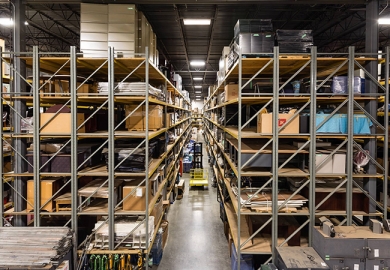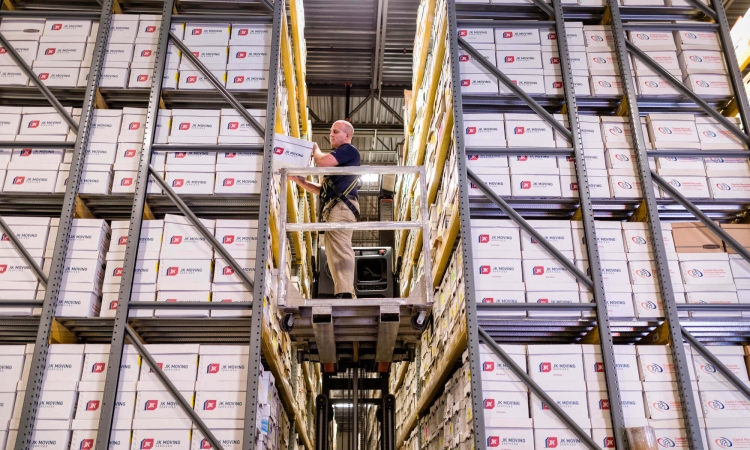Are you planning a commercial move? Do you have some extra inventory to store? It’s crucial to know if you need storage or warehousing options because both have unique advantages. Deciding which option is best for your needs can be challenging. This beginner’s guide discusses warehousing vs. storage and how each can meet various business needs.
Warehousing and storage
Warehousing and storage are terms often used interchangeably because both involve holding items for later use. In addition to storing goods, warehousing is a process. It involves a specific location designed to store goods. Warehouses often have loading docks, storage racks, temperature control, and other specialized features. Storage facilities are usually smaller than warehouses and used for storing items on a short- or long-term basis.
Warehousing
Warehousing includes storing goods while offering additional services like order fulfillment, packaging, and distribution. It’s a process that can consist of many operations, such as receiving, unloading, storage, order picking, packing, and shipping. An effective operation provides logistical solutions for storing and managing goods.
Types of warehouse facilities
- Private: Private warehouses are owned by an individual, company, or organization. Not open to the public.
- Public: Public options are open to the general public. They typically include various services like packaging and shipping.
- Automated: Automated operations use machines to move product-filled pallets, perform order picking, and more.
- Climate-controlled: Climate-controlled warehouses allow control of the environment for items sensitive to temperature or humidity. Some warehouses have freezers.
- Distribution centers: Distribution centers are warehouses with large spaces capable of moving large quantities quickly using vehicles, including forklifts and pallet jacks.
Storage
Storage is a general term referring to a temporary, safe place to hold items for various durations. Businesses often need storage options to hold overstock from seasonal inventory fluctuations, transitional periods, remodels, or other situations. The purpose of storage is to hold assets, ensuring they remain in optimal condition.
Types of storage facilities
- Personal: Personal storage units are typically rented monthly, accessible 24 hours a day, and hold household items or other personal belongings.
- Business storage: Business storage spaces are rented to hold business inventory, office supplies, equipment, or furniture.
- Climate-controlled: Climate-controlled storage helps preserve items in storage, protecting them from humidity, overheating, or freezing.
Key differences
 Location
Location
Warehouses are larger than storage facilities and, therefore, require more land. They are often located in more remote areas. Storage facilities require less land and are more common in urban or suburban areas.
Accessibility
Because they are often located in more remote areas, warehouses may be less accessible to customers. Storage areas can be found in urban or suburban areas, which are more easily accessible to customers.
Capacity
Warehouses are often large commercial buildings used for business purposes. Storage units are of various sizes, usually smaller than warehouses, making them ideal for personal and household use. Small businesses also benefit from smaller storage areas.
Security
The massive size of most warehouses makes security more difficult. Warehouses often need extra protection or CCTV throughout the facility. Storage facilities are easier to secure because they are usually smaller and less accessible to people coming and going.
Duration
Warehousing is often the first choice for long-term storage solutions and distribution processes. Storage areas are typically better for shorter storage periods.
Cost
Size and services make warehousing more costly than storage facilities. Other factors like maintenance and security add to the cost of using a warehouse.
Tips for finding the best solutions
Assess your needs
Make a detailed plan describing your needs, including duration, what you need to store, how much space you need, and any other special considerations like temperature, product movement, order fulfillment needs, and security.
Optimal location and accessibility
Choosing a location that is convenient for you and will incur minimal transportation costs when you move your goods. Also, ensuring easy access to your goods is crucial.
Scalability
The facility you choose should be able to adapt to inventory fluctuations, especially business growth.
Security
You always want to safeguard your assets, so ensure the facility you choose has adequate security measures.
Technology
Up-to-date technology is critical for inventory management and tracking.
Cost-efficiency
Compare pricing to ensure your chosen facility aligns with your budget while providing essential services. Find out if scaling up or down will impact your pricing.
Legalities
Warehousing and storage facilities must adhere to state and federal regulations and maintain required certifications. Confirm that the facilities you are considering are up-to-date and in compliance.
Check reviews and references
When shopping for a warehouse or storage facility, look at recent reviews and find client testimonials.
If you’re facing a commercial move or an inventory surplus, you might be wondering if a storage space or warehousing solution will meet your needs. This beginner’s guide serves as an introduction, describing the differences and similarities of each one. Integrating an efficient warehouse management system (WMS), implementing proficient logistics, accurate inventory control, tracking, and forecasting should all be considered as you examine your options.


